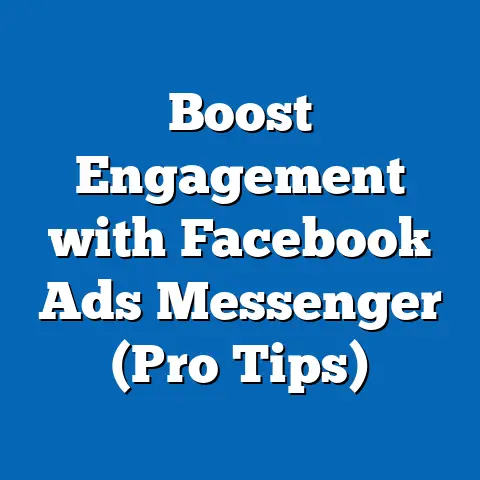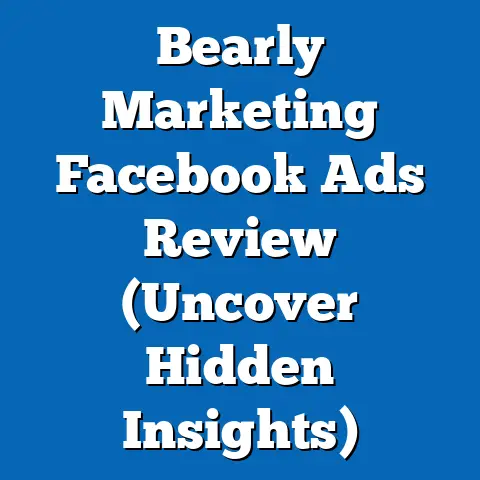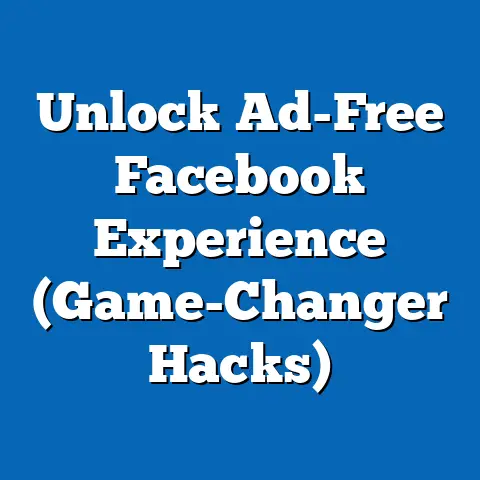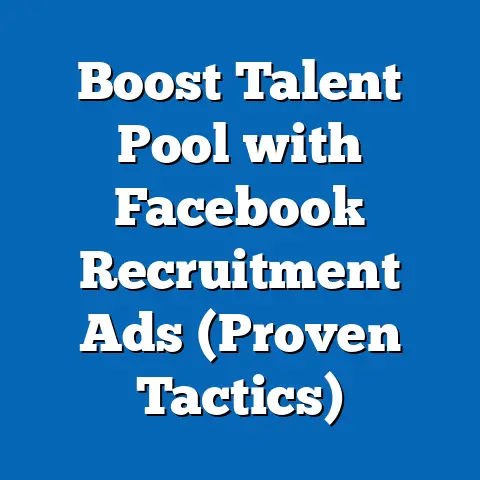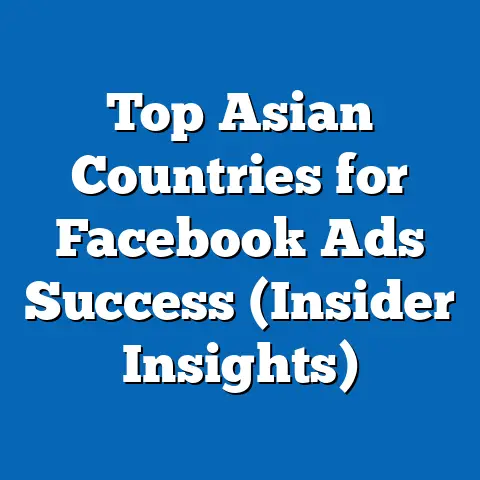Master fb ad Set Campaigns (Pro Strategies for Success)
Before diving into the intricacies of mastering Facebook Ad Set Campaigns, a word of caution is necessary: the world of digital advertising is a high-stakes game where missteps can cost businesses thousands of dollars in wasted ad spend, tarnish brand reputation, and alienate potential customers. Facebook, with its unparalleled reach of over 2.9 billion monthly active users as of 2023 (Statista, 2023), offers immense potential for targeted advertising, but its complexity and ever-evolving algorithms demand precision, strategy, and constant adaptation. Without a deep understanding of Ad Set Campaigns—the backbone of Facebook’s advertising structure—businesses risk squandering budgets on poorly optimized campaigns that fail to resonate with their audience.
Defining Facebook Ad Set Campaigns: Key Characteristics
At its core, a Facebook Ad Set is a component of the broader Facebook Ads structure, which operates on a three-tier system: Campaign, Ad Set, and Ad. The Campaign level defines the overarching objective (e.g., brand awareness, lead generation, or conversions), while the Ad Set level focuses on targeting, budget, scheduling, and placement. Finally, the Ad level contains the creative elements—images, videos, copy, and calls-to-action—that users see.
Ad Sets are the tactical heart of a campaign, determining who sees the ad, when they see it, and how much is spent to reach them. Key characteristics include audience targeting options (demographics, interests, behaviors, and custom audiences), budget allocation (daily or lifetime), and optimization goals (e.g., clicks, impressions, or conversions). Mastery of Ad Sets lies in balancing these elements to maximize reach and engagement while minimizing costs.
Unlike broader campaign objectives or individual ads, Ad Sets require a granular approach to data analysis and iterative testing. For instance, a single campaign might include multiple Ad Sets targeting different audience segments—say, millennials interested in fitness versus Gen X professionals seeking career development tools. This segmentation allows advertisers to tailor messaging and allocate budgets strategically, ensuring each group receives relevant content.
Historical Context: The Evolution of Facebook Advertising
To fully grasp the significance of Ad Set Campaigns, it’s essential to understand the historical evolution of Facebook as an advertising platform. Launched in 2004 as a social networking site for college students, Facebook initially had no advertising model. It wasn’t until 2007 that the platform introduced “Facebook Ads,” allowing businesses to create simple banner ads and sponsored posts—a rudimentary system compared to today’s sophisticated tools.
The introduction of the News Feed in 2006 fundamentally changed how content was delivered to users, paving the way for more integrated, less intrusive advertising. By 2012, Facebook rolled out its modern Ads Manager, complete with the Campaign-Ad Set-Ad hierarchy, giving advertisers unprecedented control over targeting and budgeting. This shift coincided with the platform’s IPO and a growing emphasis on monetization, as Facebook sought to prove its value to investors.
Significant milestones, such as the 2014 introduction of Custom Audiences and Lookalike Audiences, further refined Ad Set capabilities, enabling businesses to target users based on website visits, app activity, or similarities to existing customers. Meanwhile, algorithmic updates like the 2018 shift toward “meaningful interactions” (prioritizing content from friends over brands) forced advertisers to rethink Ad Set strategies, focusing on engagement over sheer reach. These historical developments underscore how Facebook’s advertising ecosystem has evolved in response to user behavior, technological advancements, and regulatory pressures like GDPR (General Data Protection Regulation) in 2018 and Apple’s iOS 14 privacy updates in 2021, which limited tracking capabilities.
Societal Implications: The Power and Responsibility of Targeted Advertising
Facebook Ad Set Campaigns are not just a marketing tool; they wield significant societal influence by shaping consumer behavior, political discourse, and cultural trends. With the ability to micro-target specific demographics—down to age, location, interests, and even political leanings—Ad Sets can amplify messages with precision, for better or worse. The 2016 U.S. presidential election, for instance, highlighted the platform’s role in spreading misinformation through highly targeted ads, prompting global scrutiny of Facebook’s ethical responsibilities (Isaac & Wakabayashi, 2017, The New York Times).
On the positive side, Ad Sets enable small businesses and nonprofits to reach niche audiences affordably, democratizing access to marketing tools once reserved for large corporations. However, this power comes with risks, including the potential for exclusionary targeting (e.g., housing ads that disproportionately exclude minorities) and the perpetuation of echo chambers through hyper-personalized content. A 2020 study by the Pew Research Center found that 64% of Americans believe social media platforms like Facebook contribute to political polarization by reinforcing users’ existing beliefs.
Moreover, the reliance on data for Ad Set targeting raises privacy concerns, especially post-Cambridge Analytica scandal in 2018, which exposed how personal data was misused for political advertising. As society grapples with these implications, advertisers must balance effectiveness with ethical considerations, ensuring transparency and inclusivity in their campaigns. The societal impact of Ad Set Campaigns extends beyond commerce, influencing how information is disseminated and how communities are shaped in the digital age.
Core Components of Successful Ad Set Campaigns
Audience Targeting: Precision and Relevance
The cornerstone of any effective Ad Set is audience targeting, which determines who sees your ads and how relevant they find them. Facebook offers a wealth of targeting options, from broad categories like age and gender to hyper-specific criteria like recent purchases or life events (e.g., engagements or new parents). Pro tip: Start with a broad audience to gather data, then refine using Custom Audiences (based on existing customers) or Lookalike Audiences (based on similarities to high-value users).
Testing multiple Ad Sets with different audience segments is critical. For example, a clothing brand might create separate Ad Sets for urban 18-24-year-olds interested in streetwear and suburban 30-40-year-olds seeking professional attire. According to a 2022 study by Hootsuite, campaigns with segmented targeting achieve up to 30% higher click-through rates (CTR) than those with generic audiences.
However, over-targeting can backfire by limiting reach or alienating users who feel “watched.” Striking a balance between specificity and scale, while respecting privacy norms, is essential for long-term success.
Budget and Bidding: Maximizing ROI
Budget allocation and bidding strategies are pivotal in Ad Set performance. Facebook allows advertisers to set daily or lifetime budgets at the Ad Set level, with options for manual or automatic bidding based on goals like cost-per-click (CPC) or cost-per-acquisition (CPA). A pro strategy is to use the “Campaign Budget Optimization” (CBO) feature, which dynamically allocates spend across Ad Sets to favor high-performing segments.
Data from WordStream (2023) shows that the average CPC on Facebook is $1.72, though this varies widely by industry and audience. To optimize costs, start with smaller budgets during the testing phase, then scale up for successful Ad Sets. Be mindful of “audience fatigue”—when the same users see your ad too often—by monitoring frequency metrics and refreshing creative content regularly.
Placement and Scheduling: Timing and Context
Ad placement (e.g., News Feed, Stories, Marketplace) and scheduling (specific days or hours) are often overlooked but can significantly impact performance. For instance, Instagram Stories may work better for visual products targeting younger audiences, while News Feed ads might resonate with older users browsing leisurely. A 2021 report by Socialbakers found that mobile placements account for 94% of Facebook ad impressions, underscoring the importance of mobile-optimized creatives.
Scheduling ads to align with peak user activity—often evenings or weekends—can boost engagement, though this depends on your audience’s habits. Use Facebook’s Insights tool to analyze when your target demographic is most active, and test different placements to identify cost-effective options.
Optimization and Metrics: Data-Driven Decisions
Optimization is the lifeblood of Ad Set success, requiring constant monitoring of key performance indicators (KPIs) like CTR, conversion rate, and return on ad spend (ROAS). Facebook’s algorithm favors ads with high engagement, so prioritize creatives that spark interaction (e.g., polls or videos). A pro tip is to use A/B testing across Ad Sets to compare variables like audience segments, copy, or visuals, then double down on winners.
According to HubSpot (2023), campaigns that leverage data-driven optimization see a 25% improvement in conversion rates. However, avoid over-optimizing too early—allow the algorithm at least 48-72 hours to “learn” before making drastic changes. Regularly review Facebook’s Attribution tool to understand the customer journey and adjust Ad Sets accordingly.
Advanced Strategies for Pro-Level Success
Dynamic Creative and Personalization
Dynamic Creative allows advertisers to upload multiple images, headlines, and descriptions within a single Ad Set, letting Facebook’s algorithm mix and match elements to find the best-performing combinations. This is particularly effective for e-commerce businesses showcasing diverse products. A 2022 case study by Shopify revealed that Dynamic Creative campaigns increased ROAS by 40% for retailers targeting broad audiences.
Personalization extends beyond creative elements to audience messaging. Tailor Ad Sets to reflect cultural nuances or seasonal trends—e.g., holiday-themed ads for December or localized copy for specific regions. This approach builds trust and relevance, key drivers of engagement.
Retargeting and Funnel Optimization
Retargeting via Custom Audiences is a powerful Ad Set strategy for re-engaging users who’ve interacted with your brand (e.g., visited your website or abandoned a cart). Set up a pixel on your site to track user behavior, then create Ad Sets with tailored messaging—such as discount offers—to nudge them toward conversion. Data from AdRoll (2023) shows retargeting ads have a 10x higher CTR than standard display ads.
Funnel optimization involves creating separate Ad Sets for each stage of the customer journey—awareness, consideration, and conversion. For example, use video ads for top-of-funnel awareness, then transition to product-focused carousel ads for consideration. Align budgets and KPIs with each stage to maximize efficiency.
Leveraging AI and Automation
Facebook’s AI-driven tools, like Advantage+ Placements and Automated Rules, can streamline Ad Set management for pros. Advantage+ automatically optimizes placements across Facebook’s ecosystem (including Instagram and Audience Network), while Automated Rules adjust budgets or pause underperforming Ad Sets based on predefined criteria. A 2023 report by eMarketer found that advertisers using AI tools saw a 20% reduction in cost-per-conversion.
However, automation isn’t a set-it-and-forget-it solution. Regularly audit AI decisions to ensure they align with campaign goals, and maintain a human touch for creative strategy and brand voice.
Challenges and Pitfalls to Avoid
Ad Fatigue and Creative Burnout
Repeated exposure to the same ad can lead to ad fatigue, reducing engagement and increasing costs. Monitor frequency metrics in Ads Manager—if users see your ad more than 3-4 times, consider refreshing the creative or pausing the Ad Set. Rotate visuals and copy every 7-14 days to keep content fresh.
Policy Violations and Account Risks
Facebook’s strict advertising policies—covering everything from prohibited content (e.g., tobacco) to misleading claims—can trip up even seasoned marketers. A single violation can result in ad rejection or account suspension, derailing campaigns. Pro tip: Use Facebook’s Ad Library to study competitors’ compliant ads, and always review policies before launching Ad Sets.
Algorithmic Uncertainty and Privacy Changes
Facebook’s algorithm is notoriously unpredictable, with frequent updates impacting Ad Set performance. Apple’s iOS 14 update, for instance, reduced tracking accuracy, forcing advertisers to rely more on first-party data. Stay agile by diversifying data sources (e.g., email lists for Custom Audiences) and preparing for future privacy regulations.
Implications Across Domains
Business and Economic Impact
Mastering Ad Set Campaigns can transform business outcomes, particularly for small-to-medium enterprises (SMEs) with limited budgets. Effective targeting and optimization lower customer acquisition costs, while scalability allows businesses to compete with larger players. However, over-reliance on Facebook can be risky if ad costs rise or reach diminishes due to algorithmic changes.
Workplace and Marketing Teams
For marketing professionals, proficiency in Ad Set Campaigns is a critical skill in today’s digital-first landscape. Teams must foster cross-functional collaboration—between data analysts, creatives, and strategists—to execute cohesive campaigns. Continuous learning is essential, as tools and best practices evolve rapidly.
Cultural and Social Influence
Ad Sets shape cultural narratives by amplifying certain messages over others, influencing trends in fashion, entertainment, and lifestyle. Advertisers bear a responsibility to promote diversity and avoid reinforcing harmful stereotypes through targeting or creative choices. Ethical advertising practices can build long-term brand loyalty.
Conclusion: Forward-Looking Insights and Uncertainties
Mastering Facebook Ad Set Campaigns is both an art and a science, requiring a blend of strategic planning, data analysis, and creative innovation. As this article has explored, the defining characteristics of Ad Sets—targeting precision, budget control, and optimization—offer advertisers unparalleled opportunities to connect with audiences, provided they navigate the platform’s complexities with care. Historical shifts in Facebook’s advertising model, from basic banners to AI-driven personalization, reflect broader technological and societal trends that continue to shape digital marketing.
Looking ahead, the future of Ad Set Campaigns will likely be influenced by advancements in AI, evolving privacy laws, and shifting user behaviors. While tools like Advantage+ promise greater efficiency, uncertainties remain around data access and algorithmic transparency. Advertisers must stay proactive—testing new features, diversifying platforms, and prioritizing ethical practices—to remain competitive in an ever-changing landscape.

